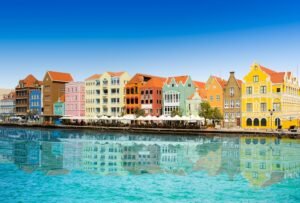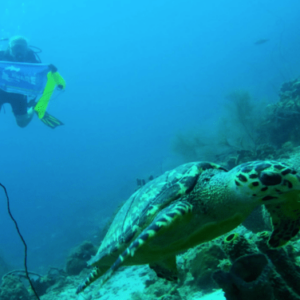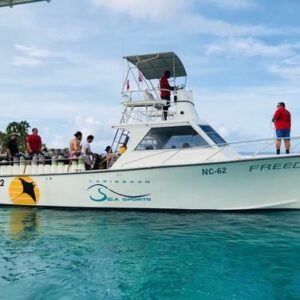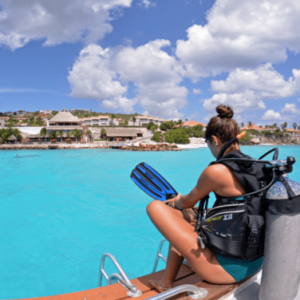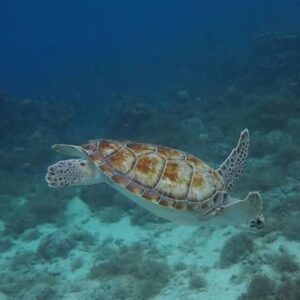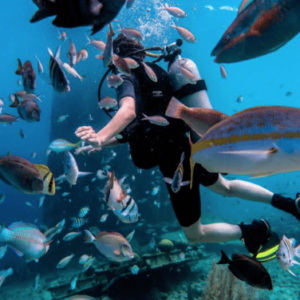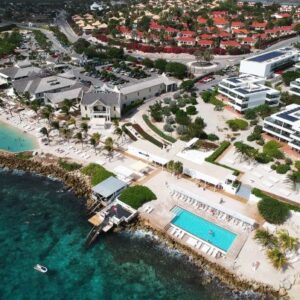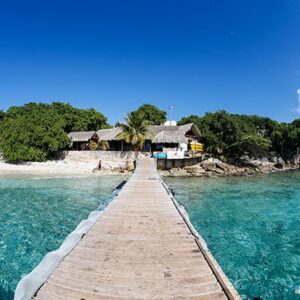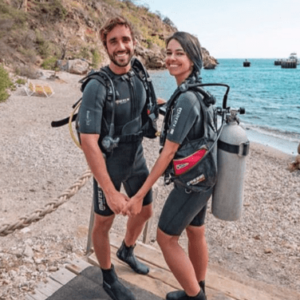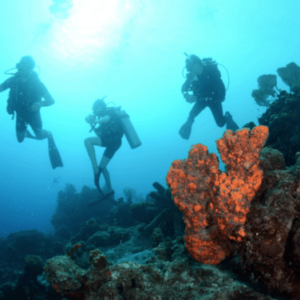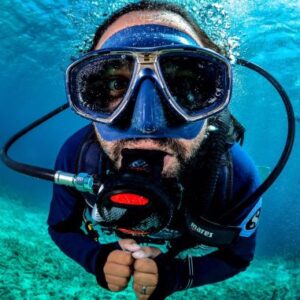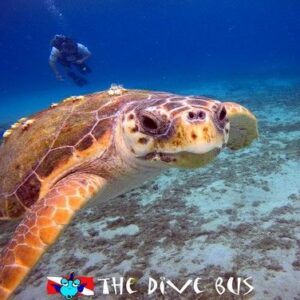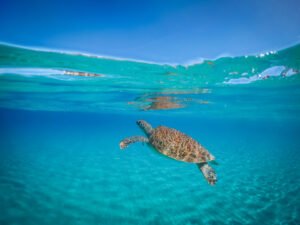The Dutch Caribbean paradise, Curacao, is home to some of the most diverse diving sites in the Caribbean. Some would argue that it is some of the best diving in the Caribbean. Curacao has scuba diving for every level of diver and preference. This beautiful little island is in the southern Caribbean Sea and is part of the ABC island chain which also includes Aruba and Bonaire. Curacao has a fringe reef that surrounds the island. It is known for its calm, clear waters and excellent visibility which makes it perfect for snorkeling and scuba diving. Divers enjoy experiencing healthy corals, macro life and an abundance of marine life. In September and October, coral spawning is a popular highlight. This event happens seven days after the full moon. Diving Curacao includes several wrecks including the best known, the Superior Producer, a protected marine park, and some great wall dives at Klein Curacao top off this amazing dive island. Add in Curacao’s pristine beaches and great topside activities and views, Curacao is a paradise waiting.
GETTING THERE
Air: Direct flights can be found daily from Miami. Weekly charters can be booked from Toronto. All flights land at Hato International Airport.
GETTING AROUND
Car Rentals: Curacao is a wonderful place to rent a car. This gives the freedom and flexibility to explore the island and visit popular attractions that are not easily accessible by public transportation.
Taxi service: Taxis are available but can be costly.
Bicycles: Bike rentals are available and are obtainable at most hotels on the island.
Train Service: The trolley train is a relaxing way to discover the downtown area of Curacao.
GOOD TO KNOW
Country: Dutch Caribbean Island which is a constituent country of the Kingdom of the Netherlands
Time Zone: UTC-4
Primary Language: The official languages in Curacao are Papiamentu, Dutch and English.
Currency: Netherlands Antillean Guilder (ANG)
Cell Phone Service: Roaming service is required.
Voltage: 127V
Passport and Visa: Tourists need a valid passport.
Hurricane Details: Hurricane season is June 1 to November 30, but Curacao is located just outside the hurricane belt.
DIVE CONDITIONS
Water Temperature: 70-80 Degrees
Water Visibility: 50-100 feet
When to Go: Curacao is a year-round diving spot. The best experiences come during the dry season from April to November.
Diving Difficulty: Beginner – Advanced
TOP DIVE SITES IN CURACAO
Curacao boasts more than 60 dive sites from which the majority are diveable from the shore, listed are some of the most famous and popular.
- Watamula (Intermediate-Advanced): The Watamula reef is off the northern tip of Curacao and is considered one of the top dive sites on the island. This site can only be accessed by boat and is often a drift dive. Scuba divers drift alone the ocean currents which gives divers a feeling of flying underwater. Large bait balls and coral heads are often encountered. Turtle and shark sightings including the rare whale sharks have been sighted here. Various sea life including parrotfish, angelfish, triggerfish, chubbs, shrimp, crabs, sea turtles, porcupine fish, stingrays, morally eels and more make Watamula home.
- Alice in Wonderland (Beginner-Advanced): Also known as Playa Kalki, this popular site is easily accessible from the beach and a favorite of snorkelers and scuba divers. The long, 30-foot rope connected to the dock sends divers to the reef. The shallows are perfect for macro work, but the reef drop off from 30 to 100 feet makes it an excellent site for beginners. There is a chance to find turtles, rays, and large schools of bait fish. Divers can expect to see trumpetfish, pufferfish, frogfish, moray eels, tangs, parrotfish, and stingrays.
- Mushroom Forest (Intermediate-Advanced): The large, hard corals at this site have grown in a way that makes them look like giant mushrooms. This mushroom coral forest provides an excellent habitat for a variety of marine species. This dive is often referred to as Curacao’s signature dive. The coral is protected by high cliffs that rise out of the water which makes it a perfect place for intermediate divers that are not experienced enough to manage rough waters. This site is accessible by boat only and divers can expect to see marine life including snapper, lobster, groupers, porcupine fish, moray eels, sea turtles and more. This site is also home to a cave known as the Blue Room. It is worth exploring when diving the Mushroom Forest.
- Booby Trap (Beginner): This dive is a favorite for beginners with a mild current, easy access, and excellent visibility. This is also a popular area for macros. Booby Trap provides a variety of hard and soft corals and sponges.
- Paradise: This secluded site is for those who love cave diving. The caves are home to a variety of marine life including turtles. The cave provides a spectacular reef.
- Superior Producer (Advanced): The Superior Producer is a 165-foot, 400-ton cargo ship that sank off the coast of Curacao in 1977. The sinking of this ship was a major loss as it was filled with merchant goods including perfume, whiskey, and clothing. This dive is accessible by boat and by shore and is suitable for advanced divers only. This wreck lies just 100 feet deep and has grown beautiful, brightly colored coral and orange sponges attracting a variety of marine life and a wheelhouse that can be explored closely. Groupers and large barracudas enjoy being up close and personal with divers, but divers will also see snapper, jack’s tarpon, and sea turtles.
- Tugboat (Beginner): Located off the coast of Tugboat Beach, this dive is appealing to beginner divers because of the exploration of the boat and its tube sponges and variety of soft corals. Lying at shallow depths, the Tugboat is great for beginners and long divers and snorkelers. The nearby pier is home to unique marine life including seahorses, octopus, scorpionfish, shrimp, lobsters, and tarpons.
- Klein Curacao (Little Curacao): This site is a long boat ride but is worth the effort. It is uninhabited which creates an area of amazing marine life in clear water. Mola Molas and hammerhead sharks are often spotted here.
- Snake Bay (Beginner-Advanced): This site’s name comes from the multiple morays and eels living here not for snakes as the name implies. If looking for a place in Curacao to as many marine animals as possible, Snake Bay is the site. Divers will have the opportunity to see wild dolphins, sea turtles, Creole Wrasses, Southern Rays, large Jacks, Caribbean Chromies, and eels. Some bigger pelagic can be found here like turtles and dolphins.
THINGS TO DO IN CURACAO
- Willemstad’s Historic Building: Willemstad is the capital of Curacao and boasts a Dutch colonial style and is a vibrant and colorful city to stroll around. It has 700 historical and cultural landmarks, such as Fortchurch which is a large, bright yellow colonial church built in 1769. Another favorite is the Queen Emma Pontoon Bridge built in 1888. Two of the four quarters of Willemstad, Punda and Otrobanda are connected by this floating bridge. Both areas are fun to explore and have exceptional shopping. Other worthwhile sights include numerous museums and the floating market.
- Mambo Beach: This white sand beach on the southwestern coast of Curacao. Mambo Beach is home to many trendy beach bars. Visitors enjoy basking in the sun, enjoying the warm, azure water and strolling from one bar to the next for cocktails and socializing. There are also some fabulous restaurants where visitors can enjoy many diverse types of cuisine.
- Christoffel National Park Hike: This beautiful park consists of 4,500 acres of protected land near the northern tip of Curacao. Visitors can hike or mountain bike along many trails. The trails are filled with brassavola nodosa also known as the lady of the night orchids.
- Day Trip to Klein Curacao: Klein Curacao or Little Curacao is an uninhibited island just off the southern end of Curacao. The trip takes about 1 hour and 45 minutes by boat. Klein Curacao is the longest beach in Curacao and a fantastic place to picnic, dive and enjoy the beautiful scenery.
Visitors to Curacao will experience picturesque views, Dutch colonial architecture and easy shore dives. This Caribbean Island features amazing coral reefs, walls, and sunken ships. The island is protected from strong currents and has fantastic visibility. The waters are warm year-round making this a great spot for beginner divers to advance. Most sites are accessible by shore and most resorts have beautiful reefs to explore. Curacao is a top diving pick!

